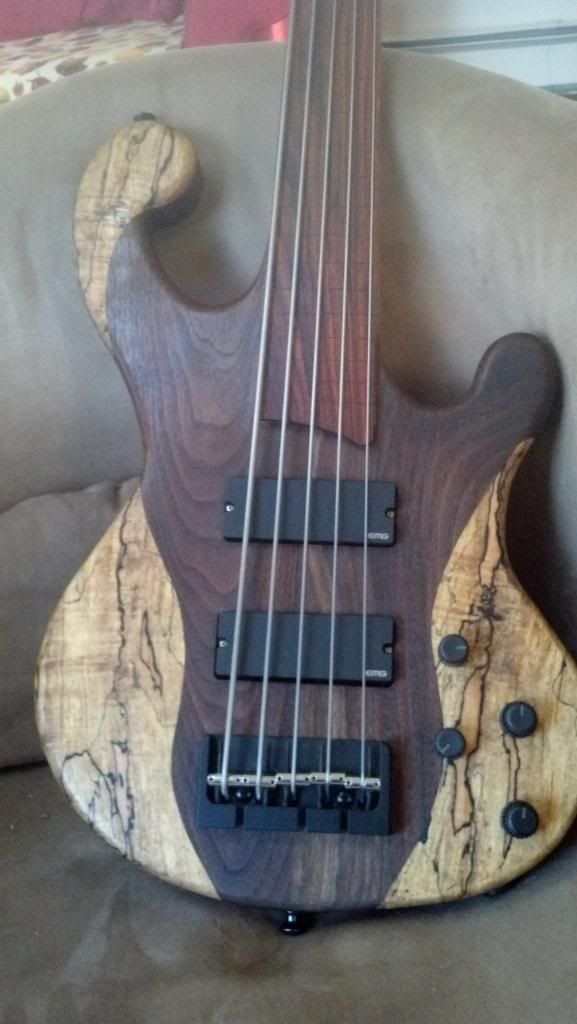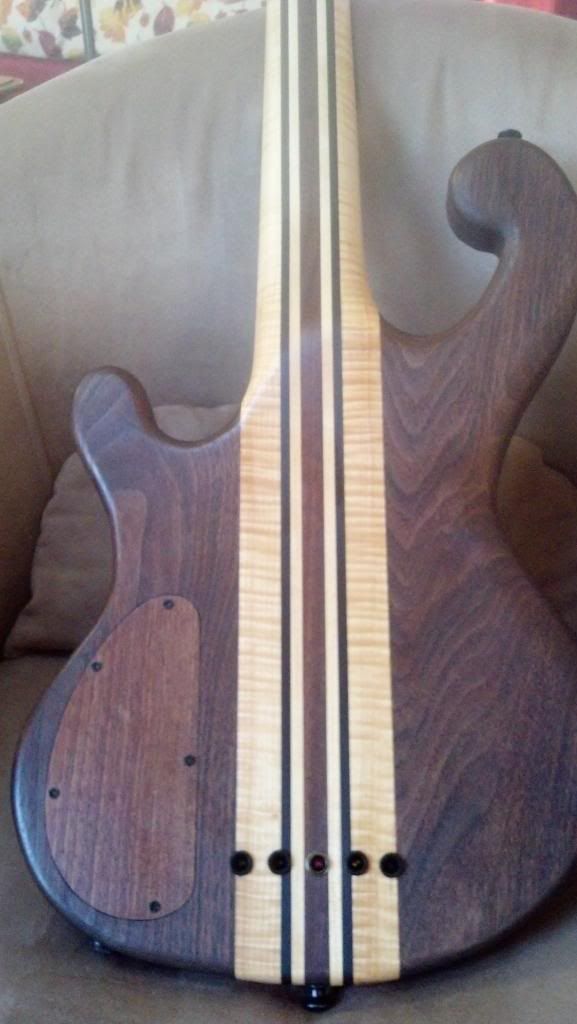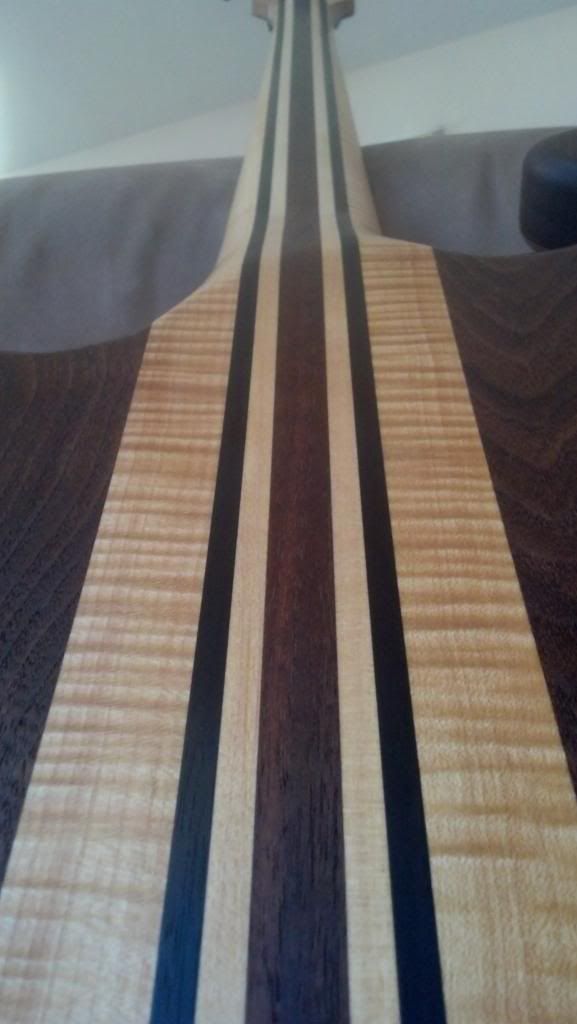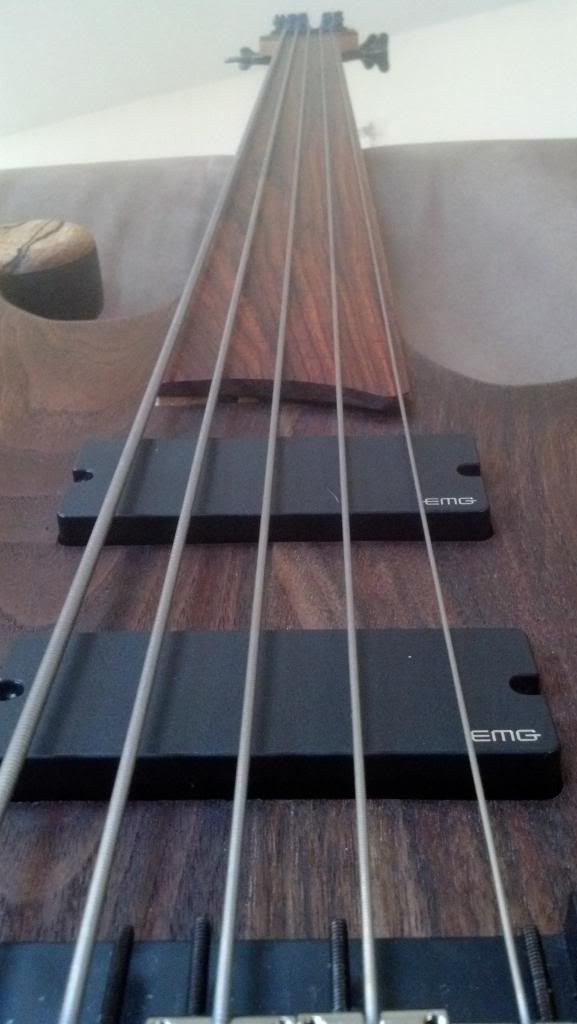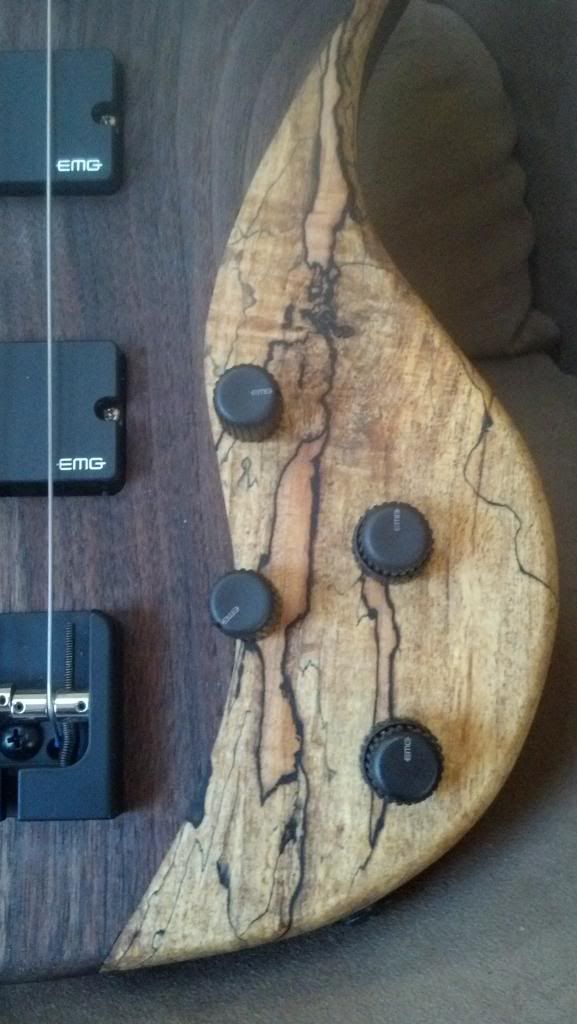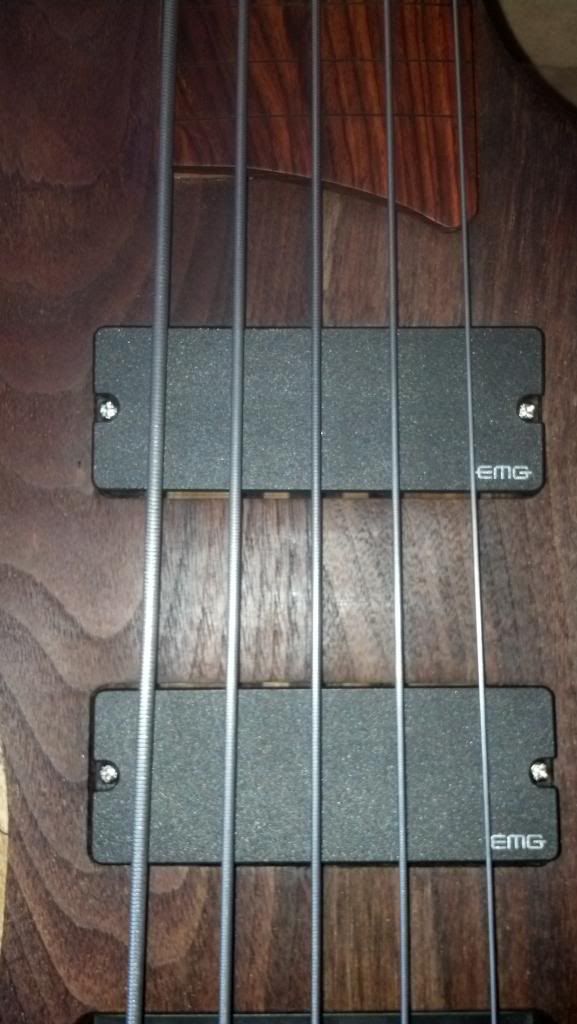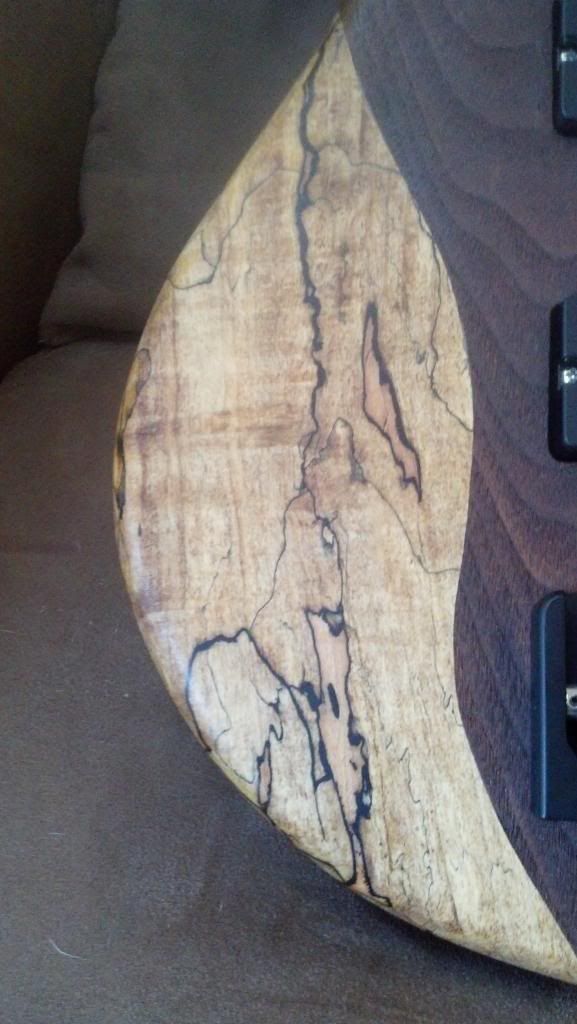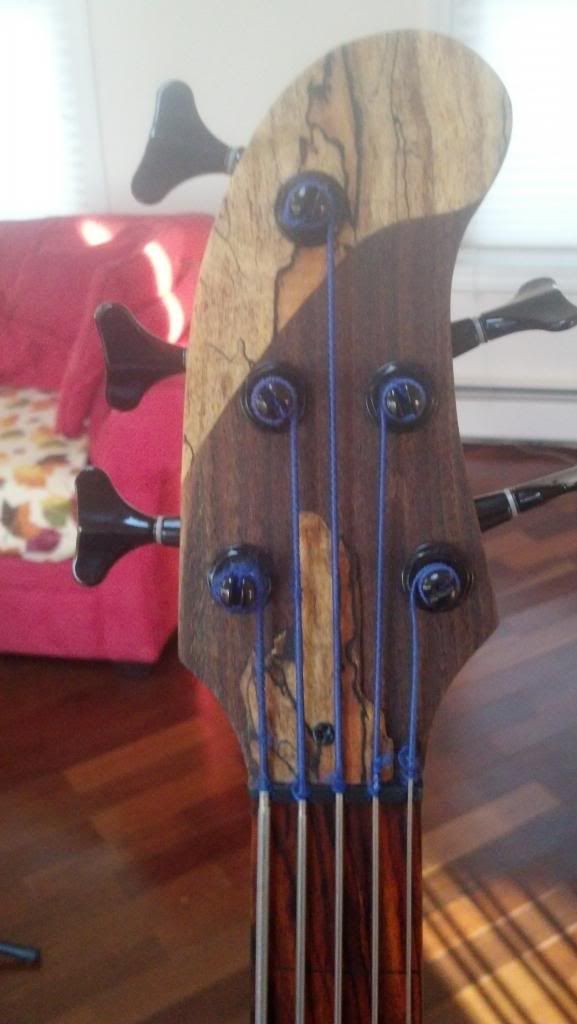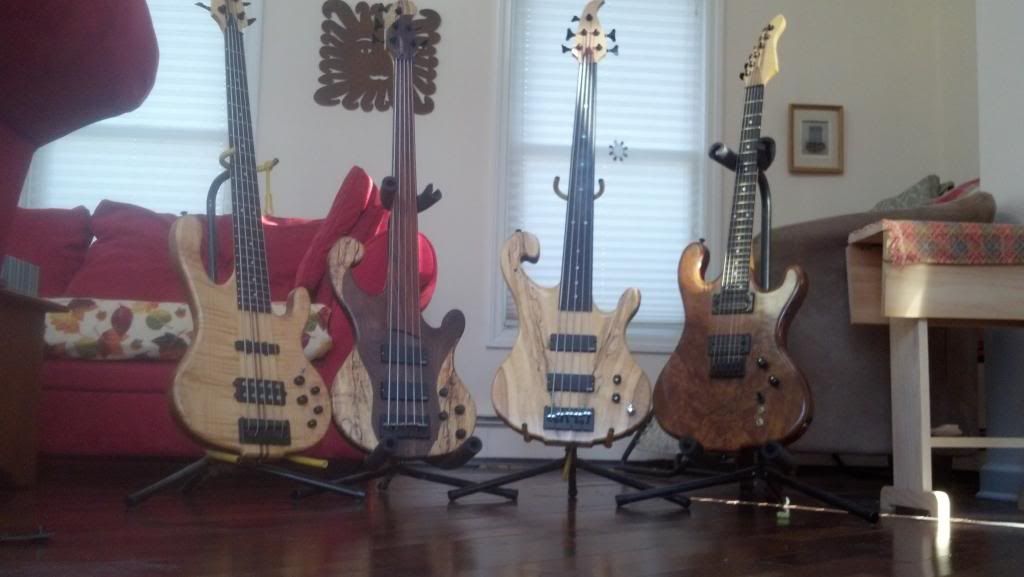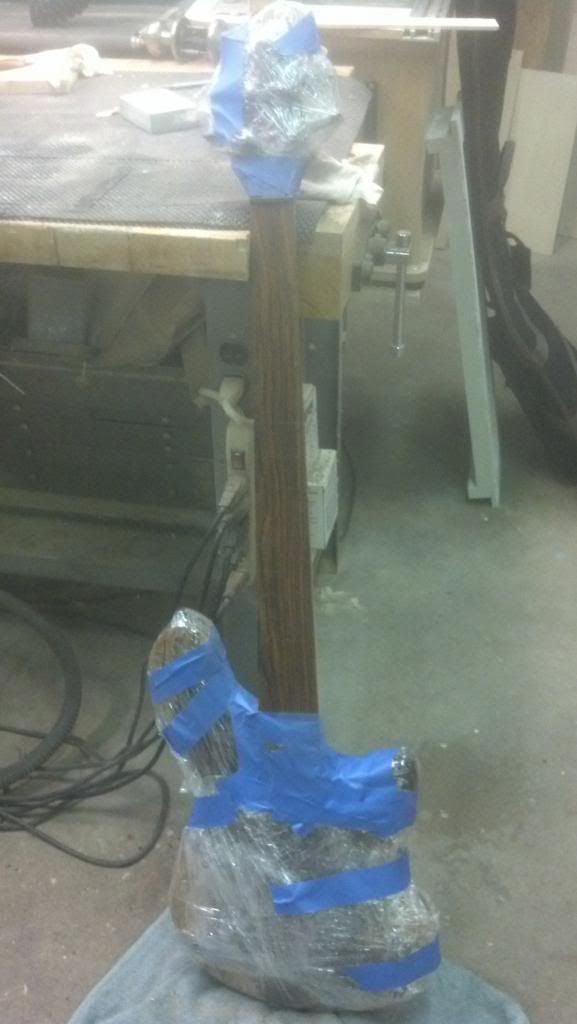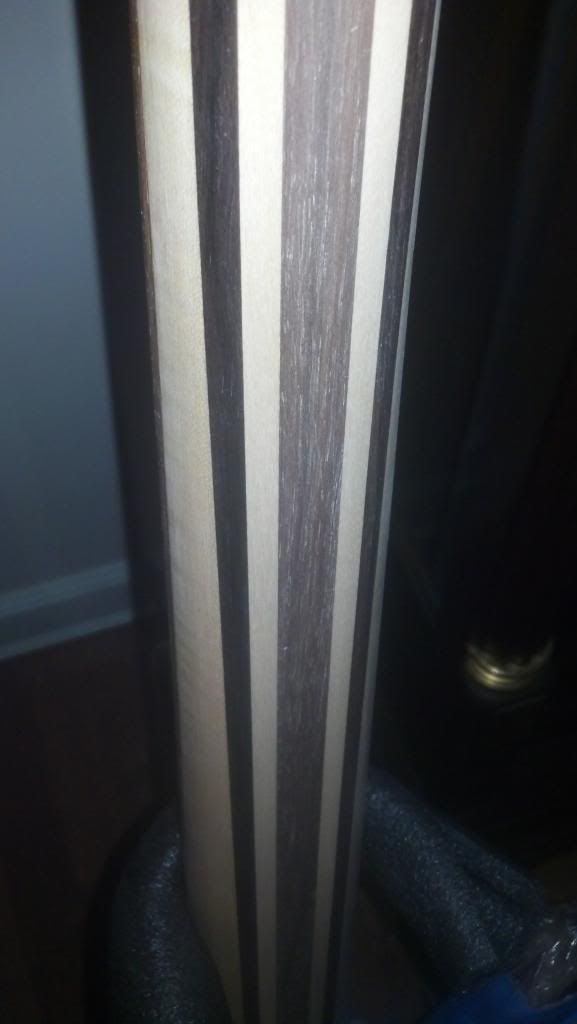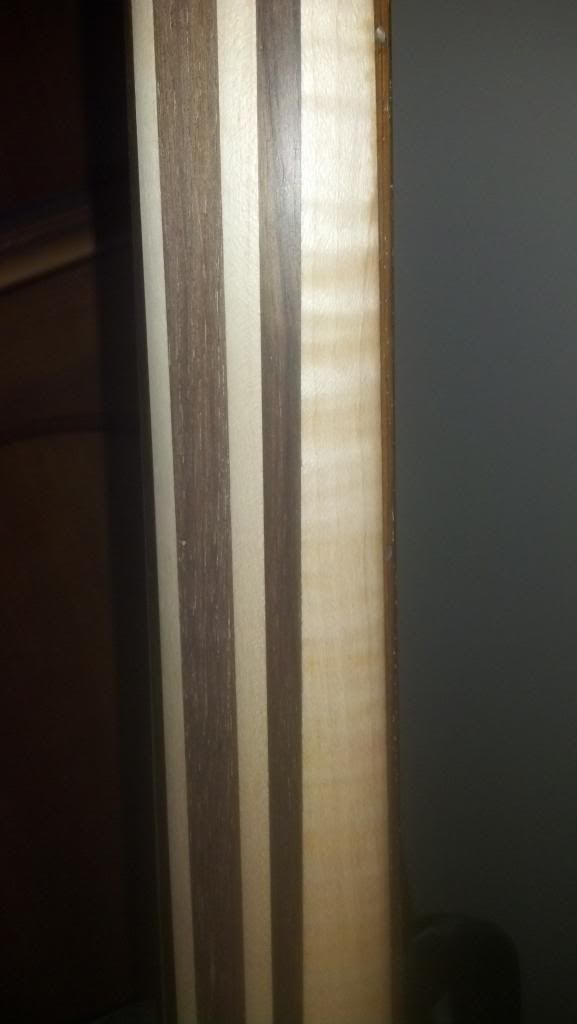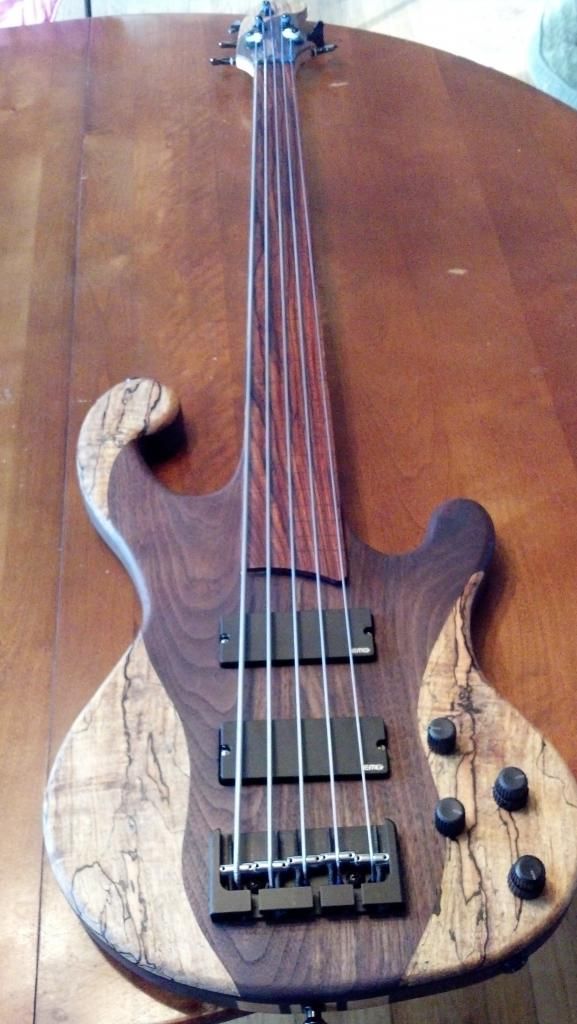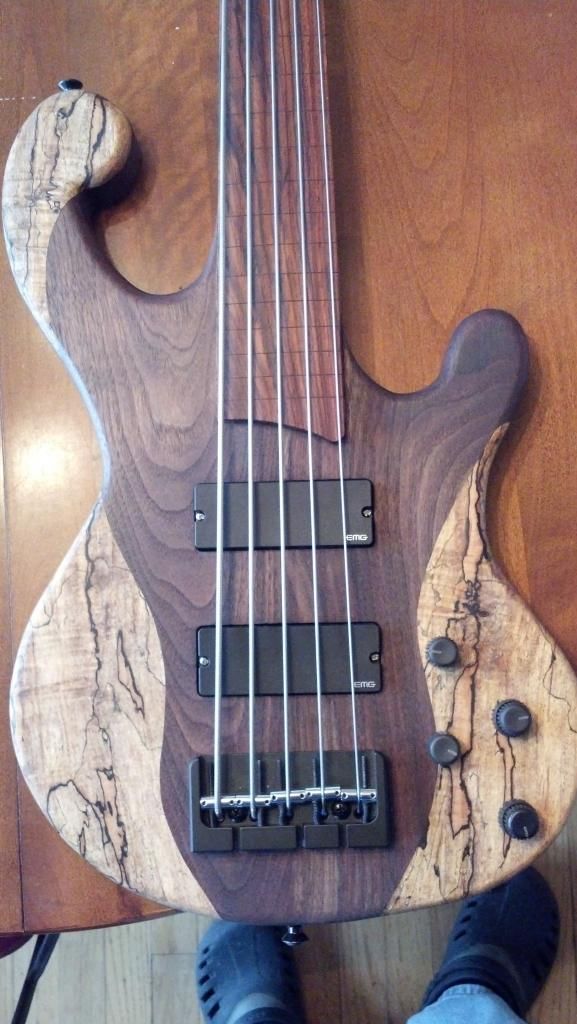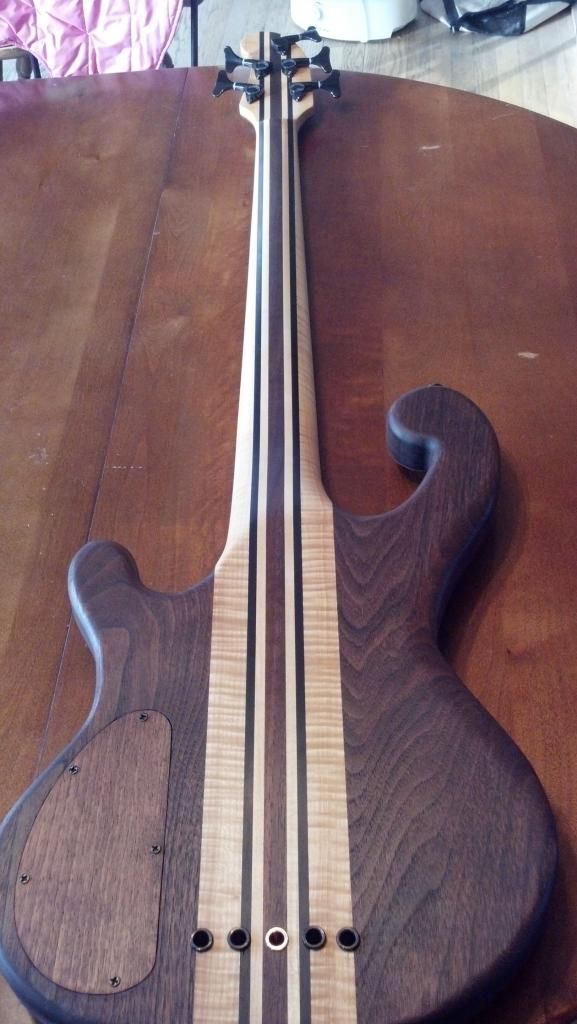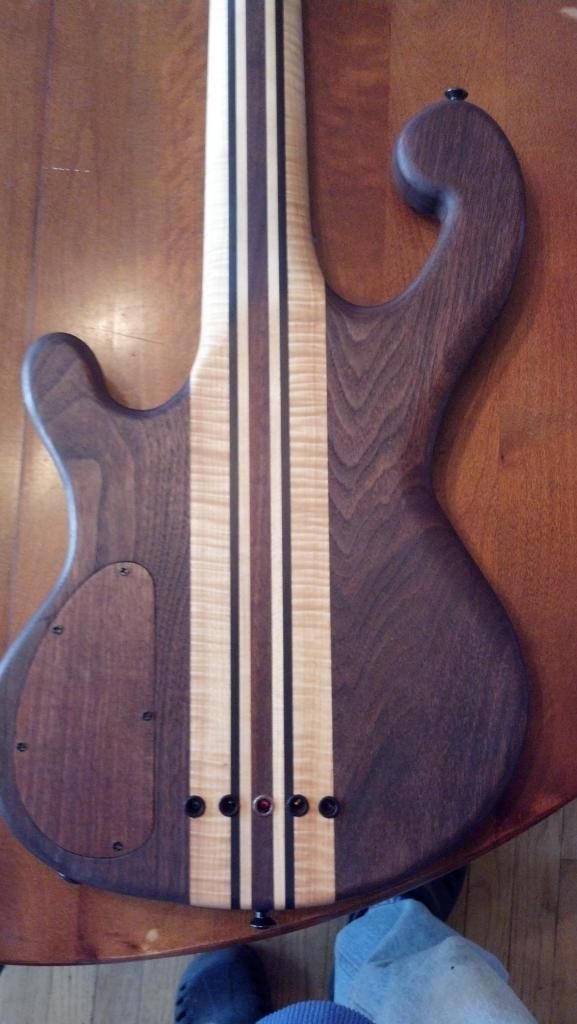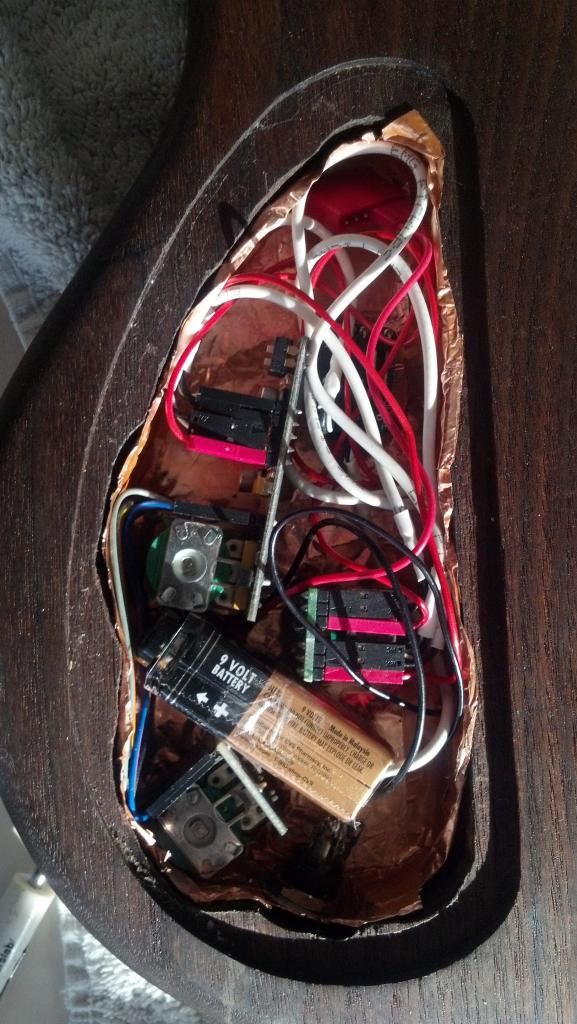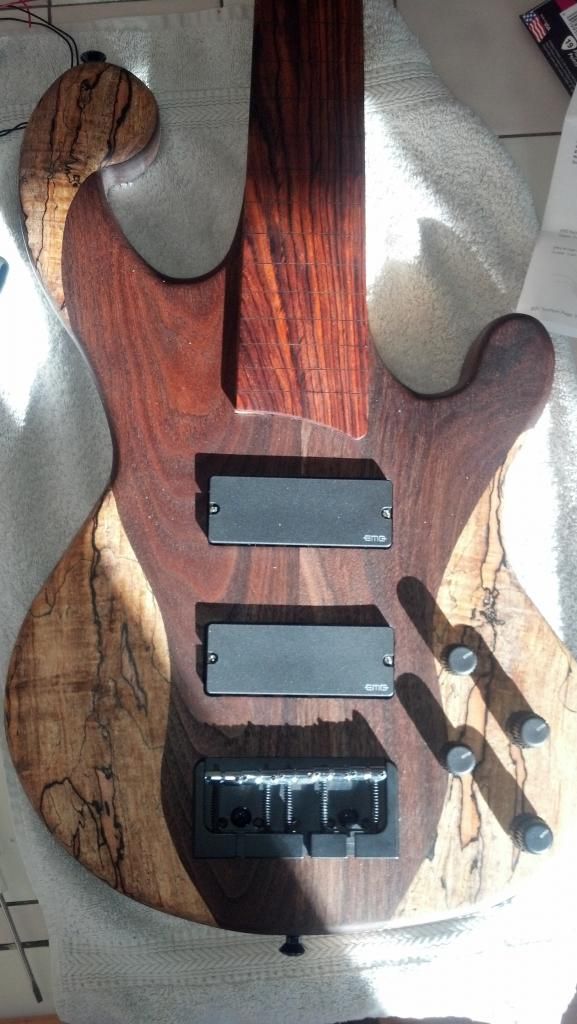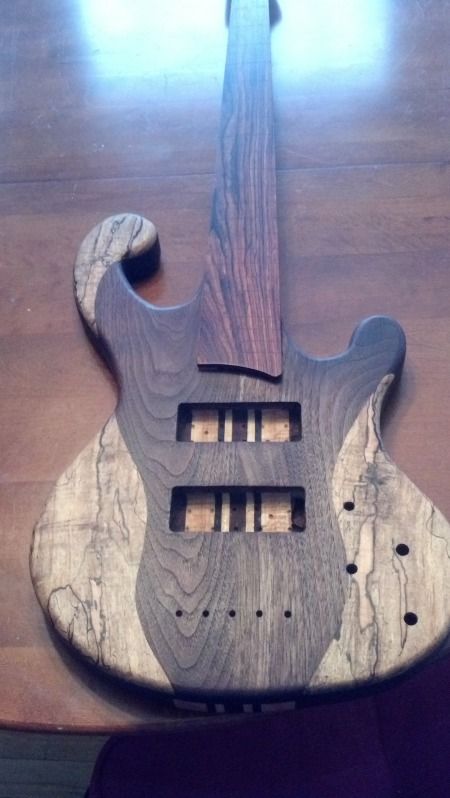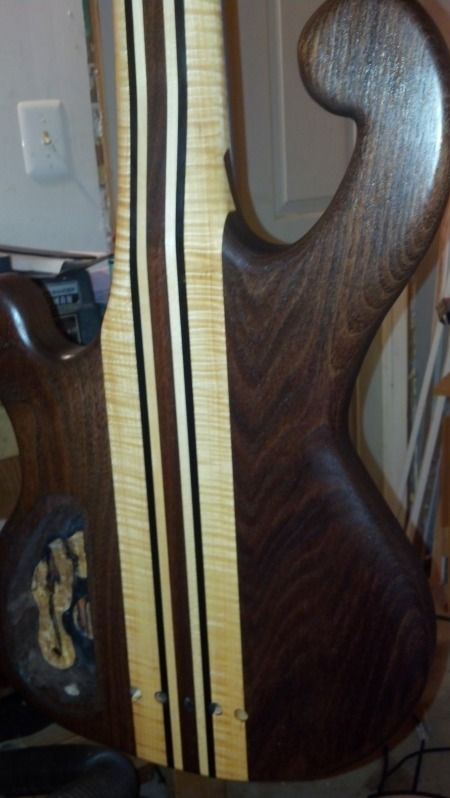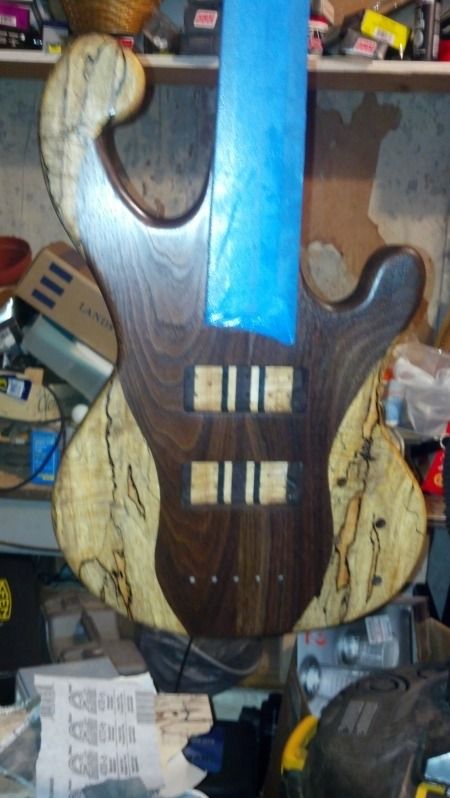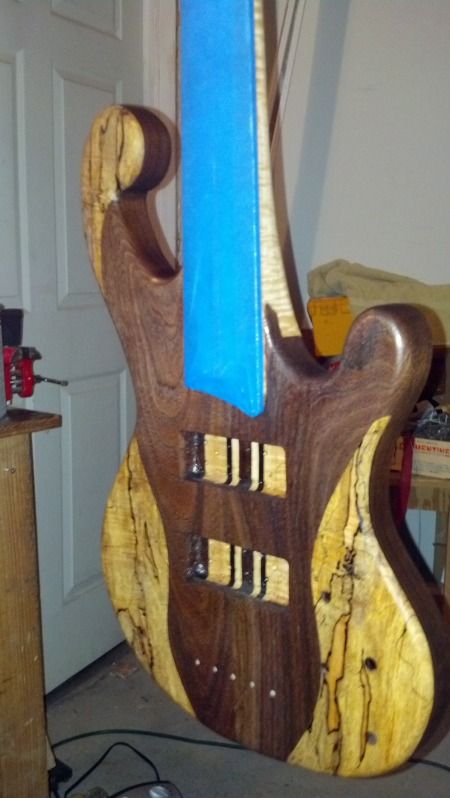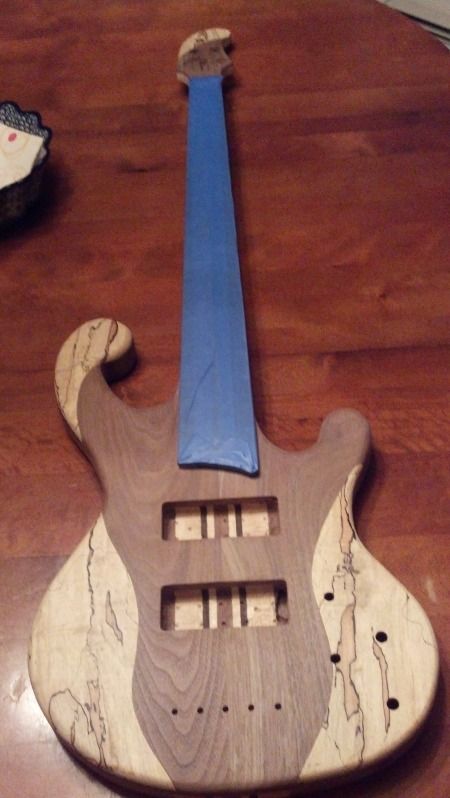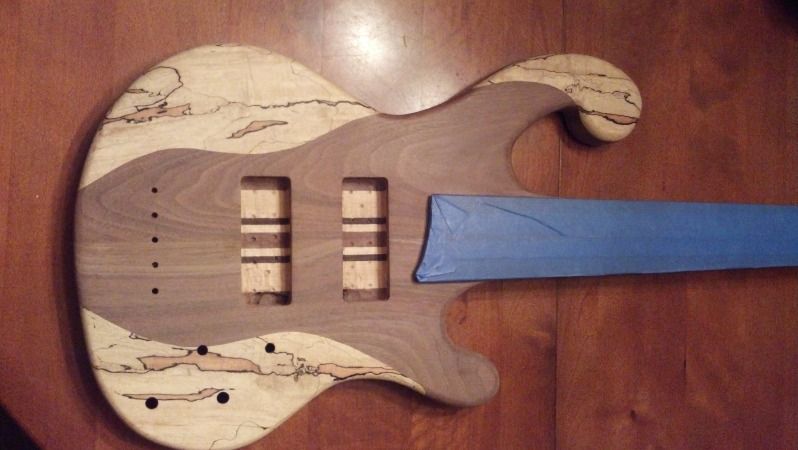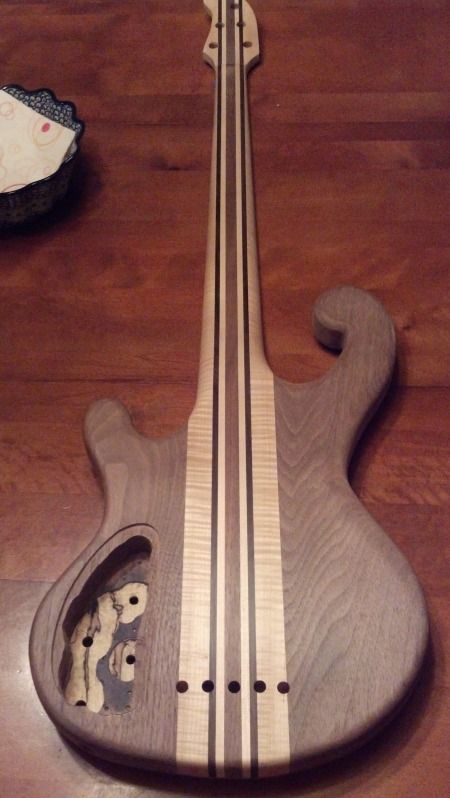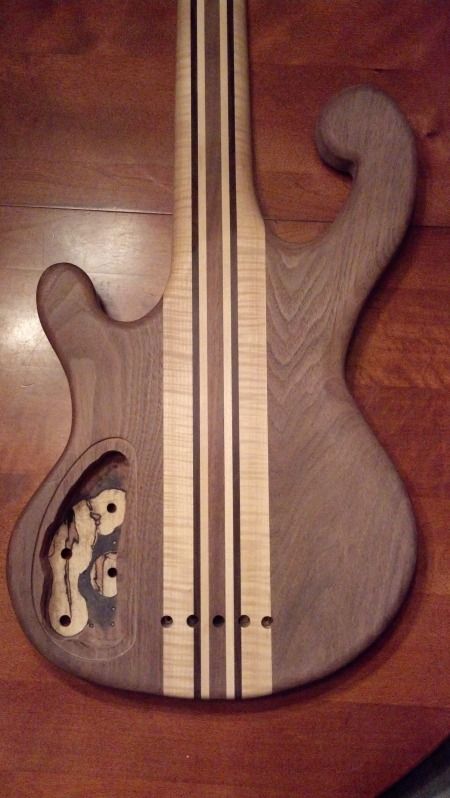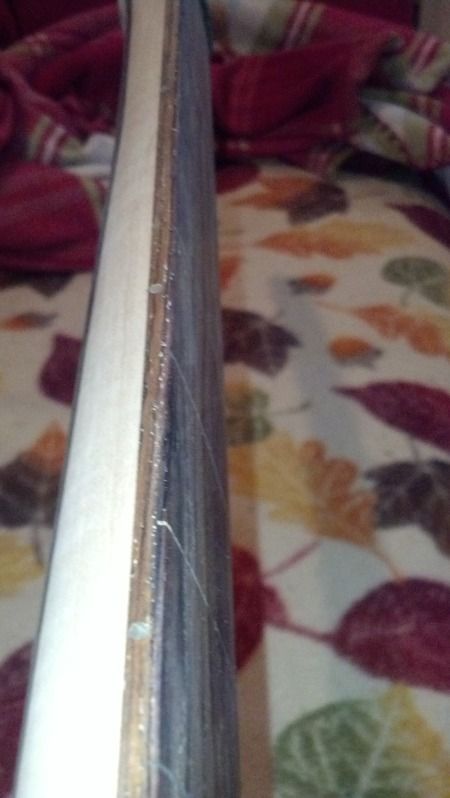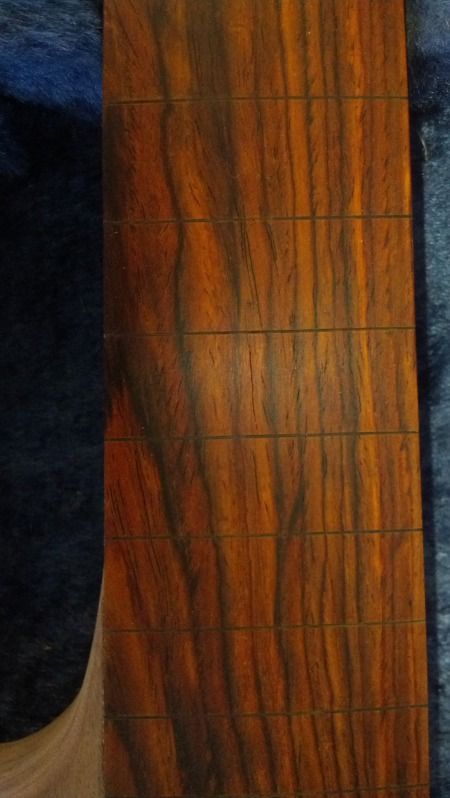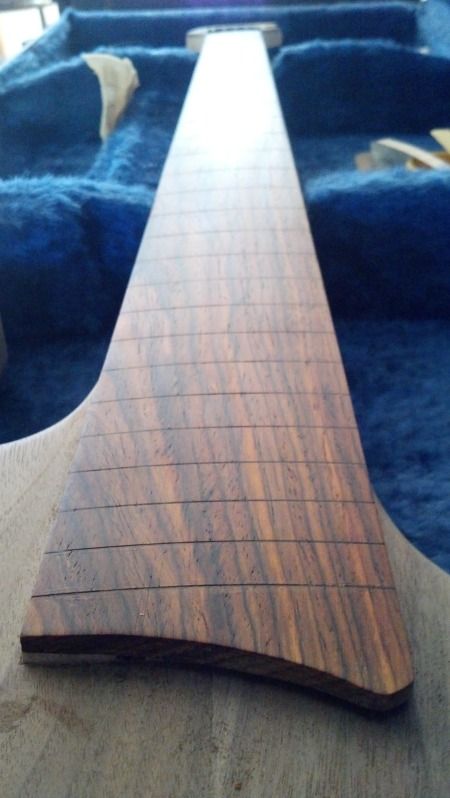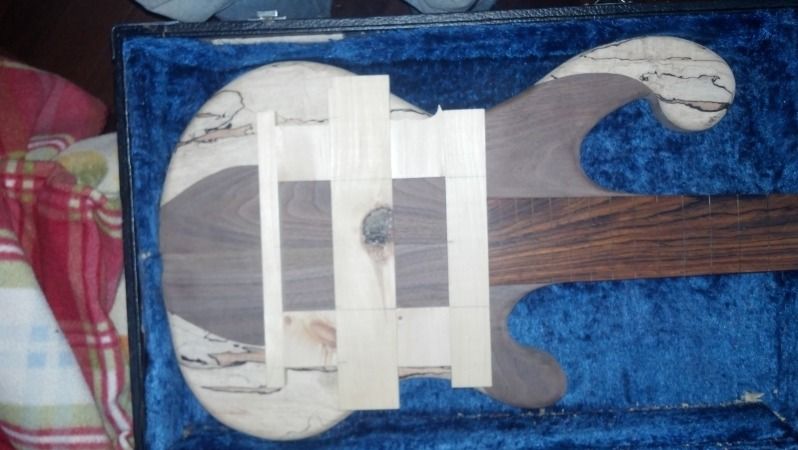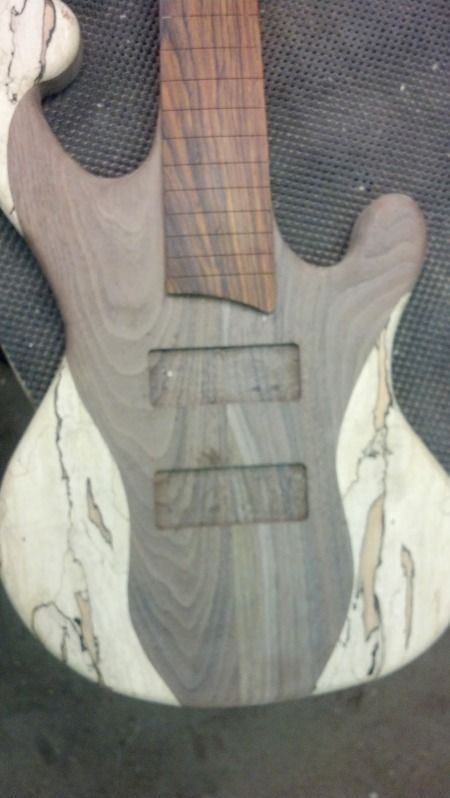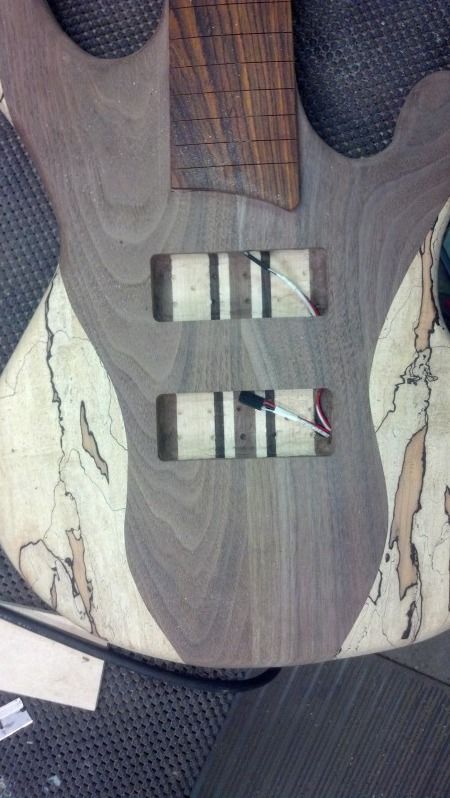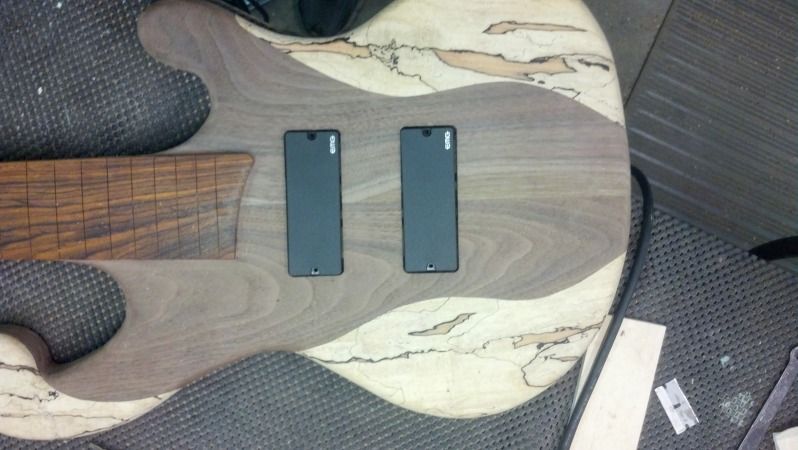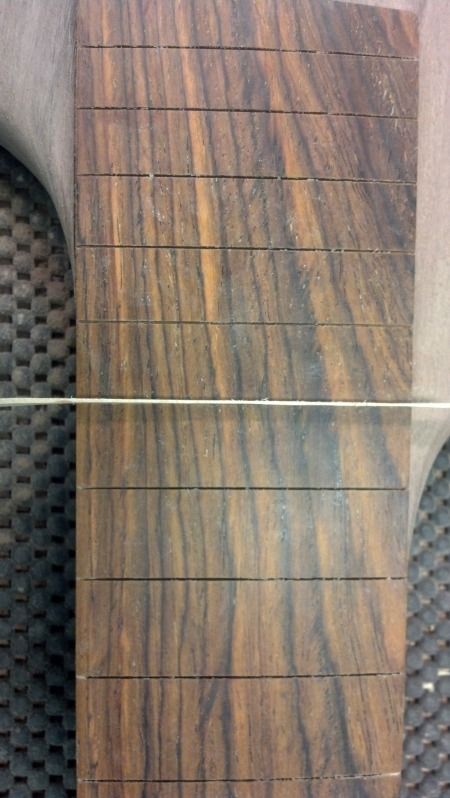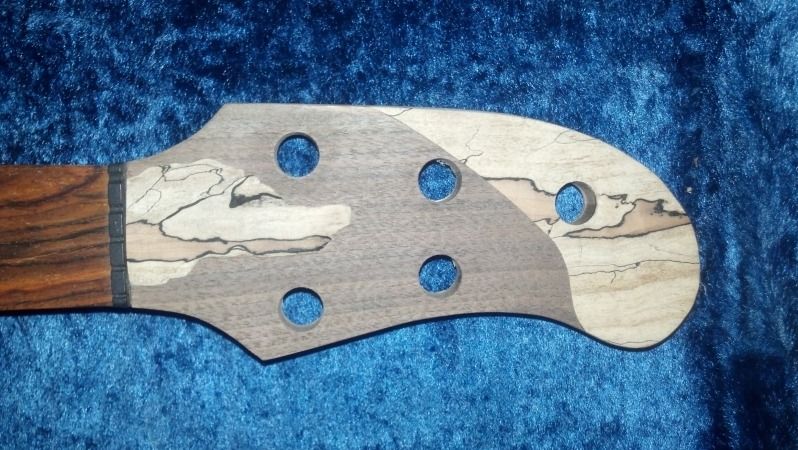I thought I'd end this build saga with a note of thanks to the people who helped me.
The first, and most obvious person, to thank is my father. While he did less on this build than others in the past, I would not have been able to do as much on my own if it weren't for his guidance on the previous instruments. On this bass build he helped me out with strategies to get different things done and cautions against some approaches I had to some difficult problems. He also did do some of the more complex operations. Its always great to have an expert right there at hand when you have a question or need help. I can't thank him enough for his willingness (insistence?) to allow me to use his shop and tools. While I tried to live the "leave it better than you found it" rule while over there, I am sure I interrupted his work, but you would never know it. I truly enjoyed spending time working with my father on this (and every other project), its great to share a passion like this. Thanks Dad!
Second, my wife Dawn. This project took about 50 hours over two months, and that's just the actual shop work. I fretted (pun intended) and talked incessantly about this for about a month before I started and throughout the whole process. I don't know how she put up with it. Saying "put up with it" sounds like Dawn just kind of passively listened to my rambling. She did way more than that, her ideas are incorporated throughout the bass - as an example those inlays were largely her idea. This is true support and not just lip service. I hope I provide some of that encouragement and support in her endeavors.
Third, my mother. I saw an episode of 30 Rock yesterday where Liz's family was featured and they were lambasted for being overly supportive. I couldn't help but think of my mother - she has been so entirely positive and complementary. I know she's my mother and she kind of has to do this, but she's really good at it and having those positive messages all the time is comforting and reassuring. Truly appreciated.
...and yes I'm scanning Ebay for wood for the next build :-D
Wednesday, November 21, 2012
Tuesday, November 20, 2012
Now its really done
I got the neck oiled and dried, for some reason the coats of oil on the neck dried really quickly. I did five coats (I think). It looks great. I'm pretty happy with how it came out, I learned a few things and the next one (yes there will be another) will be better.
On to the porn:
Front:
Back:
Front, bottom up:
Upper Inlay:
And finally a family portrait -
Left to right
My first build - a fretted five string with Carvin neck and electronics
The latest build (calling it the Case bass for now)
My third build - a fretless five string with Carvin neck and EMG electronics
My second build - a six string guitar with Carvin neck and electronics.
On to the porn:
Front:
Back bottom up:
Lower inlay:
Pickups:
Upper horn:
Headstock:
And finally a family portrait -
Left to right
My first build - a fretted five string with Carvin neck and electronics
The latest build (calling it the Case bass for now)
My third build - a fretless five string with Carvin neck and EMG electronics
My second build - a six string guitar with Carvin neck and electronics.
Sunday, November 18, 2012
Neck Liposuction
I have been hemming and hawing about the shape of the neck - I didn't like it at all - it seemed very blocky. I did some measurements and found that there was definitely some extra material on the back of the neck as well. I'm kind of upset with myself for not being more careful about this. I just hope re-finishing it isn't going to be a problem. If I have to sand this whole thing down I'm going to be pretty bummed.
Part of my reluctance to address it comes from me being afraid that in "fixing" it I would mess something up. I also had in my mind that the bass was done and going back to sanding was a bit of a let down. So while I was procrastinating I was also losing sleep, the last three days I've been thinking about how I was going to approach this. I did a stare and compare to my other basses, did some measurements with a straight edge and came up with a plan.
I went and got some finer sandpaper for the hand held belt sander figuring that was going to be my weapon of choice. The woods in the neck, especially the ebony and the maple, are extremely hard woods, so I figured the belt sander with fine paper in it would be the right tool.
I covered the bass in plastic wrap and masking tape to hopefully protect the electronics from the sawdust.
The patient ready for liposuction on the neck:
I started off with the orbital sander, just to see what it would do - it didn't work well on the narrow neck. I decided to try a sanding block with 80 grit sandpaper in it and that worked pretty well - it took me about 2 hours to take about 1/8" off the back off the neck and to round it off.
It's hard to believe how much better it looks. The pile of sawdust wasn't even that big, but it looks so much different. I can't wait to get some oil on it and get it back in the studio. I'm sure there's no way to see the difference, but here's a couple of "after" shots for good measure.
Part of my reluctance to address it comes from me being afraid that in "fixing" it I would mess something up. I also had in my mind that the bass was done and going back to sanding was a bit of a let down. So while I was procrastinating I was also losing sleep, the last three days I've been thinking about how I was going to approach this. I did a stare and compare to my other basses, did some measurements with a straight edge and came up with a plan.
I went and got some finer sandpaper for the hand held belt sander figuring that was going to be my weapon of choice. The woods in the neck, especially the ebony and the maple, are extremely hard woods, so I figured the belt sander with fine paper in it would be the right tool.
I covered the bass in plastic wrap and masking tape to hopefully protect the electronics from the sawdust.
The patient ready for liposuction on the neck:
I started off with the orbital sander, just to see what it would do - it didn't work well on the narrow neck. I decided to try a sanding block with 80 grit sandpaper in it and that worked pretty well - it took me about 2 hours to take about 1/8" off the back off the neck and to round it off.
It's hard to believe how much better it looks. The pile of sawdust wasn't even that big, but it looks so much different. I can't wait to get some oil on it and get it back in the studio. I'm sure there's no way to see the difference, but here's a couple of "after" shots for good measure.
Tuesday, November 13, 2012
First impressions
The last bass I built has three knobs on it, a smile/frown EQ and a volume for each pickup. I honestly didn't put a lot of thought into that set up when I got it, it was something a local bass builder had for sale, it was the right price and it relieved me of the hassle of figuring any of this stuff out.
There is now a website called Best Bass Gear that has so many different pickups and preamps its a bit overwhelming. I spent a few hours figuring out my options and asked them a few questions before settling on the same pickups I have in the other fretless, but changing the preamp to one that has six knobs. On this one I have treble, bass, mid-range, mid-range sweep, volume and pickup mix.
I played with everything flat to begin with, I mistakenly thought that's where I keep the controls of my other bass (it looks like I'm going to need to come up with names for my basses since I now have two fretless ones!). I wasn't happy with the tone or the output of the bass. Right towards the end of practice I started really twisting the knobs and found a sweet spot (incredibly sweet) with bass and mid-range boosted. I had a really nice slap tone for a heavier song and by pulling down the mid-range, a sweet thunky sound for a more blue grassy song. I really don't think I need to go to two batteries.
I'm thoroughly impressed. I am convinced I need to take care of that neck. I'll put some pencil lines on it today and see what I'm looking at, I have some ideas, but not sure how they will translate onto the bass. I can see that the neck needs more radius - its too square and I think I can easily take 1/8" off the back without worrying about hitting that truss rod channel. I don't think the neck will be as thin as the Carvin necks I've been using, but I should be able to slim it down considerably.
There is now a website called Best Bass Gear that has so many different pickups and preamps its a bit overwhelming. I spent a few hours figuring out my options and asked them a few questions before settling on the same pickups I have in the other fretless, but changing the preamp to one that has six knobs. On this one I have treble, bass, mid-range, mid-range sweep, volume and pickup mix.
I played with everything flat to begin with, I mistakenly thought that's where I keep the controls of my other bass (it looks like I'm going to need to come up with names for my basses since I now have two fretless ones!). I wasn't happy with the tone or the output of the bass. Right towards the end of practice I started really twisting the knobs and found a sweet spot (incredibly sweet) with bass and mid-range boosted. I had a really nice slap tone for a heavier song and by pulling down the mid-range, a sweet thunky sound for a more blue grassy song. I really don't think I need to go to two batteries.
I'm thoroughly impressed. I am convinced I need to take care of that neck. I'll put some pencil lines on it today and see what I'm looking at, I have some ideas, but not sure how they will translate onto the bass. I can see that the neck needs more radius - its too square and I think I can easily take 1/8" off the back without worrying about hitting that truss rod channel. I don't think the neck will be as thin as the Carvin necks I've been using, but I should be able to slim it down considerably.
Monday, November 12, 2012
Its finished, yet unfinished
I finished the build on Friday, but immediately after finishing it I got my new road bike. I guess I got a bit distracted, in a good way.
The bass sounds good, I am familiar with EMG pickups so no surprises there, I added a bit more tone control to this one with a sweepable midrange and the ability to adjust the mix with one knob. I'll get a recording together once this nice weather passes, the bike will continue to be a distraction.
We have band practice tonight, it will be interesting to see how it performs.
Here's some pictures of the completed bass:
So back to the title of this post. Remember when I said I was being cocky by finishing it without a test fit? Yeah, well that is coming back to haunt me. I have three issues I need to deal with before I'm happy:
1) I was able to squeeze a single 9v battery into the control cavity, I really want to put a second in there, I'll need to undercut the cavity to make room for another one.
2) The headstock doesn't angle back as much as my other basses (apparently) I had to add some spacers (in the form of zip ties) to push the strings down on the tuning peg. The fix for this is simple, cut my strings longer next time - I'm probably too cheap to throw these strings away. Stupid mistake on my part.
3) The neck is too thick front to back. I was a chicken and left probably 5/16" of material behind the truss rod. That was safe, but I need to sand down another 3/16" of material off the back of the neck. Its too thick and blocky now. I'm not sure how much difference that 3/16" will make, but it will be better than it is now.
I originally told Dawn that was going to wait until after Christmas - which is far enough away that it really means "I don't want to deal with it". After thinking about it this weekend, I think I'm going to address this stuff this week.
The bass sounds good, I am familiar with EMG pickups so no surprises there, I added a bit more tone control to this one with a sweepable midrange and the ability to adjust the mix with one knob. I'll get a recording together once this nice weather passes, the bike will continue to be a distraction.
We have band practice tonight, it will be interesting to see how it performs.
Here's some pictures of the completed bass:
So back to the title of this post. Remember when I said I was being cocky by finishing it without a test fit? Yeah, well that is coming back to haunt me. I have three issues I need to deal with before I'm happy:
1) I was able to squeeze a single 9v battery into the control cavity, I really want to put a second in there, I'll need to undercut the cavity to make room for another one.
2) The headstock doesn't angle back as much as my other basses (apparently) I had to add some spacers (in the form of zip ties) to push the strings down on the tuning peg. The fix for this is simple, cut my strings longer next time - I'm probably too cheap to throw these strings away. Stupid mistake on my part.
3) The neck is too thick front to back. I was a chicken and left probably 5/16" of material behind the truss rod. That was safe, but I need to sand down another 3/16" of material off the back of the neck. Its too thick and blocky now. I'm not sure how much difference that 3/16" will make, but it will be better than it is now.
I originally told Dawn that was going to wait until after Christmas - which is far enough away that it really means "I don't want to deal with it". After thinking about it this weekend, I think I'm going to address this stuff this week.
Friday, November 9, 2012
Its alive!
I'll get some pictures, but I got the bass together and set up. The set up took forever. There are some minor issues I need to deal with (there always are) but it sounds really nice.
Paradise found
I finished putting the electronics in this morning. After carefully situating everything I can get one battery in there. I really want to run 18v, but I guess 9v will have to suffice for now. I have a battery box for 2 batteries, but on initial look I can't find any real estate on the bass where I can route for it.
Things are tight in that control cavity:
So I'm 12 screws and 5 strings away from music - going to the hardware store now to get those screws also trying out a road bike. Could be a big day for me!
Things are tight in that control cavity:
I got the knobs on the front too - it was a stupidly long operation to get those things on, mostly my own impatience and trying to hurry it along.
So I'm 12 screws and 5 strings away from music - going to the hardware store now to get those screws also trying out a road bike. Could be a big day for me!
Trouble in paradise
Remember how I said I was being over confident by not test fitting everything? I think I might be psychic. There's not enough room in the control cavity for the batteris. I will have to either expand the control cavity or install a battery holder. I guess its not a huge deal, but I thought I was done with cutting part of this thing.
Thursday, November 8, 2012
Up from the basement
I brought the bass up from the basement this morning. After looking at it in the light (reflecting off the freshly fallen snow - in NOVEMBER!) I am going to declare the finish finished. First is the scavenger hunt for the parts I need to complete it - just some screws and springs - then the final build will commence. I could get the first notes out of it by tomorrow night.
So here it is, the body and neck have 6 coats of tung oil, the fretboard has been wiped down with lemon oil - as lemon oil doesn't "dry" like tung oil does, its hard to call that a "coat".
So here it is, the body and neck have 6 coats of tung oil, the fretboard has been wiped down with lemon oil - as lemon oil doesn't "dry" like tung oil does, its hard to call that a "coat".
Wednesday, November 7, 2012
Six coats
I've got six coats of oil on the bass. I had to put a space heater in the shop (my measly shop) to bring the temp up, it wasn't drying at all. It looks great - the wood has a ton of depth. The one bulb in the basement blew out and I had to replace it with a new one, that new bulb throws a lot more light - it looks so good! I wish the pictures did it justice. I can't wait to get the final coat done. I'll probably let it dry over night and put the final coat on tomorrow morning.
And while I forgot just how dark black walnut got when you oiled it, it's not as dark as it looks in this picture.
And while I forgot just how dark black walnut got when you oiled it, it's not as dark as it looks in this picture.
More coats
I put my fifth coat of tung oil on the bass this morning. I'd post pictures, but it looks a lot like the last one I posted. I noticed a couple of spots that should have been addressed prior to finishing - amazing how that wet oil gloss brings out the flaws! The final finish will be matte, down the road I'll have to sand it down and address these spots (there's that promise!).
The spalted maple was pretty smooth when I finished sanding - spalted maple will never be completely smooth. Boy does it absorb oil! Different parts of the wood absorb oil at different rates too, which means its not very smooth any more. I expected this as it happens every time I've used spalted, but its always surprising. The good news is that if its absorbing this much oil, it will act as a stabilizer for the wood.
I figure three coats today, maybe 2 or 3 tomorrow. I'll buff the final coat with 0000 steel wool and let it dry over night. It still looks like Friday will be bass building day. I have to get to the hardware store and get some screws for the control cavity and truss rod covers and get some springs for the pickups (the springs push the pickups up against the screws).
I need to figure out how that second screw on the back pickup is going to work - the wiring channel wiped out the spot where the screw would have gone. I can either glue in a piece of wood or maybe a small piece of right angled metal. I'll have to look at it further. That's something I probably should have worked out before starting finishing - that's the kind of time consuming thing that will drive me nuts as I put things together - I'll have to wait for glue to dry - a true test of my patience.
The spalted maple was pretty smooth when I finished sanding - spalted maple will never be completely smooth. Boy does it absorb oil! Different parts of the wood absorb oil at different rates too, which means its not very smooth any more. I expected this as it happens every time I've used spalted, but its always surprising. The good news is that if its absorbing this much oil, it will act as a stabilizer for the wood.
I figure three coats today, maybe 2 or 3 tomorrow. I'll buff the final coat with 0000 steel wool and let it dry over night. It still looks like Friday will be bass building day. I have to get to the hardware store and get some screws for the control cavity and truss rod covers and get some springs for the pickups (the springs push the pickups up against the screws).
I need to figure out how that second screw on the back pickup is going to work - the wiring channel wiped out the spot where the screw would have gone. I can either glue in a piece of wood or maybe a small piece of right angled metal. I'll have to look at it further. That's something I probably should have worked out before starting finishing - that's the kind of time consuming thing that will drive me nuts as I put things together - I'll have to wait for glue to dry - a true test of my patience.
Tuesday, November 6, 2012
Monday, November 5, 2012
Ready for finishing
At some random (it seems) point in the sanding process you have to admit to yourself that its not going to get better than it is. I'll take one final look at it tomorrow morning before applying the first coat of oil, but I think that the time has come to admit this is the best its going to look. There are small things that I think could be better, but I feel like that magical point where everything is perfect is going to remain just beyond the horizon and its time to just go for the finish. I can always tell myself I could re-do some part later on (but I know that won't happen).
I had a little problem with the fret lines - the anigre apparently doesn't absorb glue - so I ended up having to fill in the rest of the fret slots with anigre dust and glue. It looks great (under that blue tape), so no harm other than an extra hour or two of work.
I have a can of tung oil that worked great on the last bass and I'll use that one again, assuming the two test pieces I did tonight dry by morning - I have no reason to believe they won't, but I didn't want to risk it on the whole bass without trying. It doesn't smell funky so I don't think its "turned" or anything.
So here's the bass ready for finishing. Its been sanded to 320 or so. I remembered my last project sanding to 1600 grit, but I read a few articles today that said going beyond 320 is burnishing, not sanding and that's not what you want to do with an oil finish. Tung oil is really easy to apply so I expect no problems.
Finishing is pretty relaxing for me - you hit it with a coat of oil and there's nothing to do but wait - no stress in that.
I remember mounting everything on the bass taking quite a while. It seems like it should be quick, but there's a ton of little things to get done. This is the first instrument I've built where I didn't do a test fit of all the pieces. Overconfidence? Perhaps.
I have Friday off work, hopefully by then I'll be in a position to put it all together. Every other instrument I've made I've finished after coming home from work, so it ends up being a long, tiring night. I endeavor to make this one a bit more enjoyable. I remember finishing the guitar and having no sound, I had crossed some wires in the control cavity, that was an extremely long night, figuring out that mess!
I had a little problem with the fret lines - the anigre apparently doesn't absorb glue - so I ended up having to fill in the rest of the fret slots with anigre dust and glue. It looks great (under that blue tape), so no harm other than an extra hour or two of work.
I have a can of tung oil that worked great on the last bass and I'll use that one again, assuming the two test pieces I did tonight dry by morning - I have no reason to believe they won't, but I didn't want to risk it on the whole bass without trying. It doesn't smell funky so I don't think its "turned" or anything.
So here's the bass ready for finishing. Its been sanded to 320 or so. I remembered my last project sanding to 1600 grit, but I read a few articles today that said going beyond 320 is burnishing, not sanding and that's not what you want to do with an oil finish. Tung oil is really easy to apply so I expect no problems.
I really like the grain on the back of the bass - having a one piece walnut body would be cool - maybe the next one?
I remember mounting everything on the bass taking quite a while. It seems like it should be quick, but there's a ton of little things to get done. This is the first instrument I've built where I didn't do a test fit of all the pieces. Overconfidence? Perhaps.
I have Friday off work, hopefully by then I'll be in a position to put it all together. Every other instrument I've made I've finished after coming home from work, so it ends up being a long, tiring night. I endeavor to make this one a bit more enjoyable. I remember finishing the guitar and having no sound, I had crossed some wires in the control cavity, that was an extremely long night, figuring out that mess!
I think Dawn is trying to kill me
Tonight I start applying the finish on the bass. I have to consider whether to use the tung oil I have in the basement or go buy new stuff. I think this warrants new stuff, but I'll see what I have. I'm not sure if it can "go bad".
Dawn had an excellent idea - selling my first home built bass to afford parts to make my NEXT bass (I don't play the old one anymore). Great idea, but I told her that's like handing a junkie a fully loaded syringe. Maybe she's trying to get me out of the house :-D
More later...
Dawn had an excellent idea - selling my first home built bass to afford parts to make my NEXT bass (I don't play the old one anymore). Great idea, but I told her that's like handing a junkie a fully loaded syringe. Maybe she's trying to get me out of the house :-D
More later...
Sunday, November 4, 2012
Side Dots
I've never done side dots before. It is something I really should have done before I glued the wings to the neck. They came out pretty good - not great, but not bad for a first try. I had to put the ones below the wings in at an angle - I couldn't get the drill close enough to the body to make the hole straight. Once they were in I sanded them flush. You can't tell they are at an angle at all. I really need two more dots for the last fret, but I'm not going to fret about it. HAHAHAHA I crack myself up.
I also spent almost two hours sanding - so the bass is pretty covered in dust, apologies for the not so great picture.
I'll spend another hour or two sanding then its off to be finished. I'm going to stick with my prediction of finishing by the end of next weekend. I'll do a coat of sanding sealer, then sand it, then do six or seven coats of tung oil. Patience, patience, patience. Its going to be tough.
I also spent almost two hours sanding - so the bass is pretty covered in dust, apologies for the not so great picture.
I'll spend another hour or two sanding then its off to be finished. I'm going to stick with my prediction of finishing by the end of next weekend. I'll do a coat of sanding sealer, then sand it, then do six or seven coats of tung oil. Patience, patience, patience. Its going to be tough.
Saturday, November 3, 2012
Fretlines sanded down
I couldn't help myself and I ended up shaving then sanding down the fretlines last night. It looks pretty understated, which is good, but it might be a bit tough to see in low light. We will see. I cleaned it off with a tacky rag and put just a few drops of lemon oil on it. Putting lemon oil on right now was not the right thing to do, but before I did that you literally couldn't see the fret lines at all and it freaked me out.
And a view of the whole neck - not a very good view, but...
I'll need to hit the neck with the radius block again to get everything even.
I stopped by the hardware store this morning and got fine grit sandpaper - I'll start with 320 and work my way up to 1600. I see sore hands in my future. I also need to install those impossibly small side dots. I actually don't have enough - I wasn't planning on a 24 fret neck. I'll just install what I have and order more. Ugh that stupid StewMac site has very high shipping, I hate to think what its going to cost me for these tiny dots.
And a view of the whole neck - not a very good view, but...
I'll need to hit the neck with the radius block again to get everything even.
I stopped by the hardware store this morning and got fine grit sandpaper - I'll start with 320 and work my way up to 1600. I see sore hands in my future. I also need to install those impossibly small side dots. I actually don't have enough - I wasn't planning on a 24 fret neck. I'll just install what I have and order more. Ugh that stupid StewMac site has very high shipping, I hate to think what its going to cost me for these tiny dots.
Fretlines
I discussed the fretlines with my design consultant (Dawn), she suggested that the maple would be too contrasting and would add to everything going on with the bass - considering all the spalting and the figuring on the fretboard. After looking at it and thinking about it, I had to agree. We both agreed the yellow was just too yellow. We tried the black and it looks the best, so that's what I went with. Once the glue is dry I'll cut and/or sand the slats down flush with the fretboard. It seems like that anigre is thin until you try to slip it in thin lines cut in the fretboard. A few minutes with the belt sander took care of that - its one of the few bench mounted power tools I have at home.
So here's the neck all loaded up with anigre strips.
So here's the neck all loaded up with anigre strips.
Some of the slats were a bit loose, hopefully the glue will expand the anigre and there will be no gaps.
Friday, November 2, 2012
Pickup Cavities
Despite many distractions I got 3 hours in on the bass today. It felt like progress.
I re-made the template for the pickup cavity, shortening the distance between the two pickups. The bass with the template on clamped on (this is before I reduced that middle section:
I made two passes with the router - this put the router bit down as far as it would go - probably about a quarter inch into the wood.
Then I used a Forstner bit in the drill press to make the cavities deep enough for the pickups, looks messy eh? Notice there are not wiring channels in sight. It gave something to think about for a few moments, but I knew where it was.
Then I took a hand held roto-grinder (not sure what this thing is really called - kind of like a really powerful dremel tool) and ground out all the extra material. My first thought was to use a chisel to do this. The chisel works great on the walnut, but that maple and ebony is tough, so I reverted to the roto-grinder. I ran into the wiring channel and tested to make sure it was big enough to get the wires and the connectors through. Now the cavities look nice and clean:
And test fit the pickups:
I re-made the template for the pickup cavity, shortening the distance between the two pickups. The bass with the template on clamped on (this is before I reduced that middle section:
I made two passes with the router - this put the router bit down as far as it would go - probably about a quarter inch into the wood.
Then I used a Forstner bit in the drill press to make the cavities deep enough for the pickups, looks messy eh? Notice there are not wiring channels in sight. It gave something to think about for a few moments, but I knew where it was.
Then I took a hand held roto-grinder (not sure what this thing is really called - kind of like a really powerful dremel tool) and ground out all the extra material. My first thought was to use a chisel to do this. The chisel works great on the walnut, but that maple and ebony is tough, so I reverted to the roto-grinder. I ran into the wiring channel and tested to make sure it was big enough to get the wires and the connectors through. Now the cavities look nice and clean:
And test fit the pickups:
I also got the string holes drilled, but I didn't take any pictures of that - this bass will have a through-body bridge - you feed the string through the back of the bass and through the bridge. Its supposed to have magical effects on the sustain of the bass, I just like the way it looks. I also took a little off the headstock (again no picture) and sanded down the whole body again - its really starting to come together.
Next I have to put in the wood in to make the fretlines. I can go either dark or light here - someone warned me not to use light wood because it gets dirty and loses some its contrast. I think that might be ok. I'm leaning towards maple right now - I could use that anigre for a dark black line. I also found a piece of really yellow wood in my Father's shop, I tried a piece of that, but it just looks weird. There is this stuff called bloodwood that is dark red, that actually might look good as the fretboard has some reddish tones in it. I guess theoretically I could finish the rest of the bass before I put the fretlines in, but that's just procrastinating the decision, I'm not above that, but...
Here's the maple, after looking at the picture, I think that's the way I'm going:
Truss rod cover and pickup template
I skipped yet another bike ride last night to work on the bass, I'm going to have some catching up to do to get back in shape once this is over. Its really the first trip to the shop that I don't feel was entirely productive.
I made a truss rod cover out of a piece of spalted wood. Tough to get such a small piece of wood so thin. I used the bench mounted belt sander, its kind of amazing I have all the skin left on my fingers. I am not 100% sold on this as a truss rod cover, but I guess it looks cool in one respect. I guess the reason I am on the fence with it is because its the only "natural" shape on the bass - not sure if it fits in with the other shapes of the spalted maple.
I guess in looking at the picture, it looks ok:
I still need to shape that headstock a bit more, its too blocky, I will make the bottom swing in a bit more above that second hole and I'll take a little off the top in between the second and third hole.
I also made the template for the pickup cavity routing. I'll go as deep as I can with the router (1/4" or so) then use the drill press and a forstner bit to pull out the rest. With the neck in the way, I can't get the router down deep enough to use it to clear all the wood. The forstner bit is a lot faster and less nerve wracking. I'll finish it off with a chisel like I did the control cavity. I did a test run with the template - I might need to adjust things a bit, it seems like there is too much space between the pickups, which is a pain, but a lot easier to fix now than after I get the holes cut! I'll draw in the bridge and figure it out once I see how it will all line up. I suppose that's the reason it didn't feel productive, making the template took a lot of time, I know it doesn't look like much, but there's always these little things that pop up.
I'm on vacation today (though calls this morning) and I have some yard work to catch up on, a couple of Craigslist sales to conduct (all to fund a new road bike!), then the work shop. Its going to be a busy day!
Subscribe to:
Posts (Atom)
